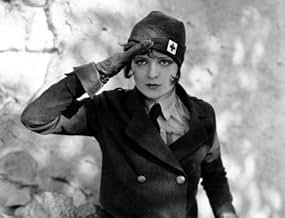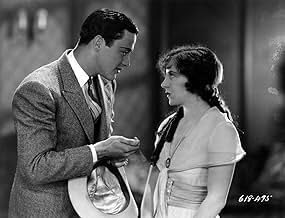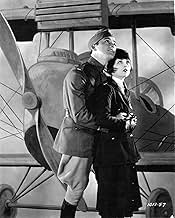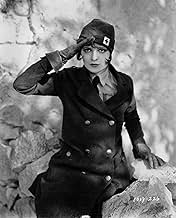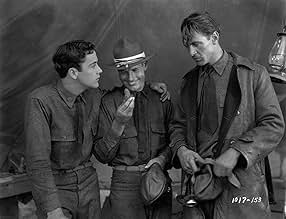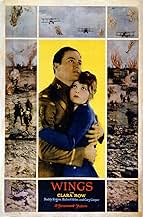VALUTAZIONE IMDb
7,5/10
15.521
LA TUA VALUTAZIONE
Due giovani, uno ricco e uno borghese, innamorati della stessa donna, diventano piloti di caccia nella prima guerra mondiale.Due giovani, uno ricco e uno borghese, innamorati della stessa donna, diventano piloti di caccia nella prima guerra mondiale.Due giovani, uno ricco e uno borghese, innamorati della stessa donna, diventano piloti di caccia nella prima guerra mondiale.
- Regia
- Sceneggiatura
- Star
- Vincitore di 2 Oscar
- 9 vittorie e 1 candidatura in totale
Charles 'Buddy' Rogers
- Jack Powell
- (as Charles Rogers)
Charles Barton
- Soldier Flirting with Mary
- (non citato nei titoli originali)
Thomas Carr
- Aviator
- (non citato nei titoli originali)
Thomas Carrigan
- Undetermined Role
- (non citato nei titoli originali)
Margery Chapin
- Peasant Woman
- (non citato nei titoli originali)
Andy Clark
- Undetermined Role
- (non citato nei titoli originali)
Recensioni in evidenza
The first movie to win the Best Picture Oscar was this terrific WW1 aviation epic from Paramount Pictures and director William Wellman. Charles "Buddy" Rogers stars as Jack Powell, a small town guy who quickly joins up for the Air Corps when the US enters World War One. He's joined by David Armstrong (Richard Arlen), the town rich kid. Both Jack and David are in love with Sylvia Lewis (Jobyna Ralston), although Sylvia only feels the same about David. Top-billed Clara Bow is Mary Preston, Jack's girl-next-door who is secretly in love with him, so much so that she joins the ambulance corps in order to get sent overseas, too. Someone should have pointed out to her just how big France is. Jack and David become close friends in the crucible of war, but life is often short for a fighter pilot.
The aerial photography is truly incredible, and is the real highlight, although the ground warfare scenes are huge in scope and well-choreographed. The performances are all very good. Rogers and Arlen have a real bromance, and both exude star power. Cooper made quite a splash in an early, very small role. Bow is fun, but her scenes almost seem to be from a different movie. The movie also won an Oscar for Best Engineering Effects, a precursor to the special effects award. While this doesn't quite rise to the epic heights of The Big Parade, this is very good, and makes a good companion piece with that film in their depiction of "the Great War". Recommended.
The aerial photography is truly incredible, and is the real highlight, although the ground warfare scenes are huge in scope and well-choreographed. The performances are all very good. Rogers and Arlen have a real bromance, and both exude star power. Cooper made quite a splash in an early, very small role. Bow is fun, but her scenes almost seem to be from a different movie. The movie also won an Oscar for Best Engineering Effects, a precursor to the special effects award. While this doesn't quite rise to the epic heights of The Big Parade, this is very good, and makes a good companion piece with that film in their depiction of "the Great War". Recommended.
David's expressions, when he is saying good-by to his family, are absolutely wrenching. The only one who overacts is Clara Bow, but she's supposed to be the bubbly, irrepressible girl-next-door, so I give her a pass.
(Was the yellow colorization added to flames then or recently? I found it distracting.)
The uniforms are perfectly detailed too, perhaps because the actual war was so recently in people's memories. Modern movie-makers have gotten very careless about uniform details, I think because they assume no one will notice.
Wonderful scene in the Folies Bergere -- note the female couple at one table in the opening clip -- nothing is new under the sun.
Beautifully digitalized restoration,astonishingly crisp. What a national treasure!
(Was the yellow colorization added to flames then or recently? I found it distracting.)
The uniforms are perfectly detailed too, perhaps because the actual war was so recently in people's memories. Modern movie-makers have gotten very careless about uniform details, I think because they assume no one will notice.
Wonderful scene in the Folies Bergere -- note the female couple at one table in the opening clip -- nothing is new under the sun.
Beautifully digitalized restoration,astonishingly crisp. What a national treasure!
This entertaining and occasionally impressive movie is still well worth seeing in spite of its flaws. The combat scenes alone make the rest of it worth watching, and Clara Bow gives a very good performance. She has plenty of energy as always, and here she makes her character especially sympathetic. But it has its weaknesses, too. The story is contrived and full of obvious holes, and except for Bow most of the acting is rather routine (Buddy Rogers is as likable as ever, but no more).
The highlights of "Wings" come in the battle scenes, and they are awfully impressive. Done without computers or other such advantages, they are exciting and are usually completely realistic. The aerial dogfight scenes are especially dazzling. This part of the movie is not shallow stuff, either, since it has a good balance between the thrilling and the horrifying. If the main story-line had been better, this could have worked very well as a classic film about the realities of war and its effects on the young persons who must carry the heaviest load in a war.
But unfortunately, it has the story that it has, which could easily have been better. It is far too heavy-handed, and is also riddled with unlikely coincidences, implausible developments, strange decisions by the characters, and many other such holes. If you can somehow look past all these problems, then it produces some moving and emotional moments, but such moments are too often undone by the contrived ways that they are set up. It's just the kind of mess that has often impressed the individuals who vote for well-known awards, but a movie with such strengths deserved to have a much better plot.
Nevertheless, it is still well worth watching for its strengths, and not just because it is the answer to some trivia questions. Just in case there are any modern movie fans who have accidentally wandered into the silents section of the database, please don't think that this is the best of what silent cinema has to offer, just because it won an arbitrary award. There are many silent film masterpieces that are vastly better than this. But it's good entertainment, and has some portions that were made with great skill.
The highlights of "Wings" come in the battle scenes, and they are awfully impressive. Done without computers or other such advantages, they are exciting and are usually completely realistic. The aerial dogfight scenes are especially dazzling. This part of the movie is not shallow stuff, either, since it has a good balance between the thrilling and the horrifying. If the main story-line had been better, this could have worked very well as a classic film about the realities of war and its effects on the young persons who must carry the heaviest load in a war.
But unfortunately, it has the story that it has, which could easily have been better. It is far too heavy-handed, and is also riddled with unlikely coincidences, implausible developments, strange decisions by the characters, and many other such holes. If you can somehow look past all these problems, then it produces some moving and emotional moments, but such moments are too often undone by the contrived ways that they are set up. It's just the kind of mess that has often impressed the individuals who vote for well-known awards, but a movie with such strengths deserved to have a much better plot.
Nevertheless, it is still well worth watching for its strengths, and not just because it is the answer to some trivia questions. Just in case there are any modern movie fans who have accidentally wandered into the silents section of the database, please don't think that this is the best of what silent cinema has to offer, just because it won an arbitrary award. There are many silent film masterpieces that are vastly better than this. But it's good entertainment, and has some portions that were made with great skill.
This film is, no doubt, a timeless triumph of the silent cinema. I first saw it three years ago and have seen it at least 30 times since then. I've only looked back to see that I have it in my collection...but not on DVD! These studios need to start thinking back to the days in which movies as good as these were made and stop producing so much garbage that they think will make tons of money without considering whether it's done right or not. This film taught me just how important gesture and body language can be in the acting world, whether it be on film or on stage. I know just how "in-character" an actor is just by looking at their face, their eyes, and how they're written in the script. Don't get me wrong, people can overact and underact in certain parts, but if you do anything without considering your character's expression or mood, regardless of whether or not your voice is unbearable to hear, you will never see success past the sound of crickets hiding in the audience. The industry knew that sound was coming. Most didn't accept this truth, but they knew it alright! "Wings" reminds those who've seen it, as with most classics of the silent cinema, that ACTIONS SPEAK A MUCH GREATER VOLUME THAN THE SPOKEN WORD. I've said all I need to say, and now I'll let this picture speak for itself.
Wings (1927)
An epic WWI movie that uses all the classic approaches to a war film and has a lot of great battle footage. It's a tale of rivalry over a girl, of fighting for country (and against the Germans), and of facing death. There are several scenes that make death really gruesome--blood spurting from a pilot's mouth, or a man crushed under a tank--that took me by surprise. I didn't know that such a mainstream American film would go there.
"Wings" is in a way exactly what American movies would look like thereafter--not just war movies, but all of them. By that I don't mean directors studied this movie and it was the inspiration from here on. But just that the story line, the romance, and even the filming, adventurous but straight on, with more attention to characters and plot than visual effect, all of this would be how films would be made for decades. Including many more by the director, William Wellman, who is one of handful of truly expert but never quite daring and inventive directors of classic Hollywood.
To back this up neatly, compare this film to the other film that jointly won Best Picture this year (the first year the Oscars were given, and the only year when the best picture category had two separate parts). That is Murnau's "Sunrise." Never mind which is better ("Sunrise," easily by most accounts). Notice how this film is utterly conservative and "conventional" in its approach to the art of making movies. It's superbly well done, but well within the rules of the time. Yes, there are moments of inspiration, including some double-exposed stock where a scene takes play in the sky over another scene on the ground. But "Sunrise" shows the lyrical art of the camera, and of editing, and of a less literal kind of storytelling. "Wings" is probably much easier to watch for most people--that's the idea. But "Sunrise" is far more engaging and complex, begging you to watch it twice. I doubt anyone needs to see "Wings" a second time.
But then, I have to admit the acting makes more sense in this film. The naturalism of the three leads helps you get emotionally involved. The most famous by far is the woman, Paramount's biggest star, Clara Bow. She doesn't get a huge role (the men do the fighting and flying) but at least when she's there she's a treat. The flying is actually done by the actors, and many of the people involved were veterans (including Wellman, who was a WWI pilot himself).
It's pretty exciting to find this so exciting all these years later. Give it a look. It's been restored really well (there's even a new Blu-Ray release). And it looks great. Don't expect anything new from the story or the filmmaking, but just expect a really well made high drama affair.
An epic WWI movie that uses all the classic approaches to a war film and has a lot of great battle footage. It's a tale of rivalry over a girl, of fighting for country (and against the Germans), and of facing death. There are several scenes that make death really gruesome--blood spurting from a pilot's mouth, or a man crushed under a tank--that took me by surprise. I didn't know that such a mainstream American film would go there.
"Wings" is in a way exactly what American movies would look like thereafter--not just war movies, but all of them. By that I don't mean directors studied this movie and it was the inspiration from here on. But just that the story line, the romance, and even the filming, adventurous but straight on, with more attention to characters and plot than visual effect, all of this would be how films would be made for decades. Including many more by the director, William Wellman, who is one of handful of truly expert but never quite daring and inventive directors of classic Hollywood.
To back this up neatly, compare this film to the other film that jointly won Best Picture this year (the first year the Oscars were given, and the only year when the best picture category had two separate parts). That is Murnau's "Sunrise." Never mind which is better ("Sunrise," easily by most accounts). Notice how this film is utterly conservative and "conventional" in its approach to the art of making movies. It's superbly well done, but well within the rules of the time. Yes, there are moments of inspiration, including some double-exposed stock where a scene takes play in the sky over another scene on the ground. But "Sunrise" shows the lyrical art of the camera, and of editing, and of a less literal kind of storytelling. "Wings" is probably much easier to watch for most people--that's the idea. But "Sunrise" is far more engaging and complex, begging you to watch it twice. I doubt anyone needs to see "Wings" a second time.
But then, I have to admit the acting makes more sense in this film. The naturalism of the three leads helps you get emotionally involved. The most famous by far is the woman, Paramount's biggest star, Clara Bow. She doesn't get a huge role (the men do the fighting and flying) but at least when she's there she's a treat. The flying is actually done by the actors, and many of the people involved were veterans (including Wellman, who was a WWI pilot himself).
It's pretty exciting to find this so exciting all these years later. Give it a look. It's been restored really well (there's even a new Blu-Ray release). And it looks great. Don't expect anything new from the story or the filmmaking, but just expect a really well made high drama affair.
Oscars Best Picture Winners, Ranked
Oscars Best Picture Winners, Ranked
See the complete list of Oscars Best Picture winners, ranked by IMDb ratings.
Lo sapevi?
- QuizWas lost for decades until a copy was discovered languishing in the Cinematheque Francaise film archive in Paris, France.
- BlooperThe film is set during the years 1917-1918, but most of the female civilian clothes and hairstyles are contemporary with the late 1920s, particularly the clothes worn by Clara Bow in the home sequences and in the Folies Bergère sequence. Bow and almost all the other female characters have bobbed hair, common in 1927 but almost non-existent during World War One.
- Citazioni
Sergeant in Mervale: Hey, if youse guys need kissin' *I'll* kiss you - wit' a gun-butt!
- Versioni alternativeSome showings have trimmed Clara Bow's brief topless scene.
- ConnessioniEdited into The Eagle and the Hawk (1933)
- Colonne sonoreThe Star Spangled Banner
(credited on 2012 restored score only)
Written by John Stafford Smith & Francis Scott Key
I più visti
Accedi per valutare e creare un elenco di titoli salvati per ottenere consigli personalizzati
- How long is Wings?Powered by Alexa
Dettagli
Botteghino
- Budget
- 2.000.000 USD (previsto)
- Lordo in tutto il mondo
- 1684 USD
- Tempo di esecuzione2 ore 24 minuti
- Colore
- Mix di suoni
- Proporzioni
- 1.33 : 1
Contribuisci a questa pagina
Suggerisci una modifica o aggiungi i contenuti mancanti







